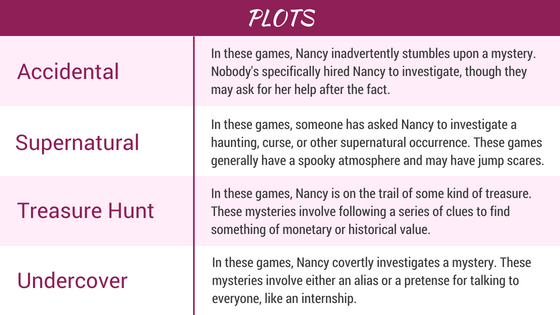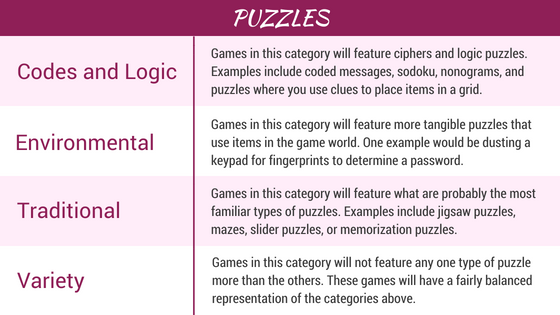It's Up to You As Nancy Drew
This year marks the 20th Anniversary of the HerInteractive series of Nancy Drew adventure games for PC, which started with the release of Secrets Can Kill on December 23, 1998. To date, the adventure series includes 32 unique adventure games, a remastered version of the original Secrets Can Kill, two games in the ill-fated Nancy Drew Dossier series, and a few trial adaptations of the games for other platforms. The games present a fantastic role model, feature a variety of educational topics, encourage critical thinking skills, and have engaging mysteries and puzzles.
I played my first Nancy Drew game, Treasure in the Royal Tower, when I was 8 years old. These games were a significant influence on my childhood and I continue to replay them on a regular basis. In honor of the anniversary of the first game, I wanted to write about the series, but I knew I could not objectively rate each game in the series due to nostalgia and personal preferences. So, instead of a series of reviews for each individual game, I have categorized each game by a number of factors- plot, puzzle type, play time, etc- and compiled the data to discuss the series as a whole, and guide you to games within the series based on your own interests and preferences, rather than the games I consider to be my favorites.
Plot
I started with plot. After shuffling around sticky notes for a while, I grouped the games' plots into four categories: accidental, supernatural, treasure hunts, and undercover. Since there is the potential for overlap between these categories, for the purposes of this analysis, plot refers to how the mystery starts, and the crime categorizations later in this post identify the theme of the investigation itself. Nancy may be on vacation or working at an internship when she stumbles upon the mystery. The mystery may start with a strange, potentially supernatural incident. Nancy may discover the first in a series of clues to find a hidden treasure. Or Nancy may be hired to go undercover to solve the mystery. Personally, I enjoy the undercover mysteries the most, but the distribution is fairly even, with the most prominent category being mysteries Nancy wanders into, rather than ones she is asked to solve.
Setting
Next, I was interested in the settings for the games. As you can see from the graphic below, most of the games take place in the United States. However, Nancy does travel to other countries, including Italy, France, Ireland, Japan, and Egypt. There are a few places that serve as the setting of multiple mysteries, including Colorado, Illinois, and the United Kingdom. Not only do the games feature other countries as backdrops for the mystery, they also incorporate culture and language into the narratives of the games. For example, you may need to communicate key words in Italian on a stakeout with the Italian police, or you may need to make foreign cuisine to earn some money as you investigate the mystery.
Subject
One of the valuable aspects of these games is that in addition to being entertaining and featuring a positive role model, they teach critical thinking and other practical skills. In fact, 90% of the time someone asks me "How did you know that?" the answer is "from a Nancy Drew game." Most games feature an educational topic that populates the reading material within the game. In Treasure in the Royal Tower, the books you find discuss the French Revolution and Marie Antoinette, for example. Although a game may cover several subjects, each game can be categorized by the most prominent subject type:
General: These games cover a variety of information without a specific focus.
Science & Nature: These games feature topics like entomology or forensics.
Travel: These games feature foreign countries, cultures, and languages.
History: These games feature historical topics or periods in history.
Crime
Similar to plot, which I've designated as the premise of the mystery as you start playing the game, I also decided to categorize the games by the crime that has been committed. In the first Nancy Drew game, Secrets Can Kill, Nancy investigates the murder of a high school student, but the series avoids another murder mystery for the next two dozen games (excluding the remastered version of Secrets Can Kill). Most games focus on either sabotage or a curse/haunting, and there's overlap between these categories - what is thought to be a curse turns out to be sabotage, etc. Other crimes Nancy will investigate range from death threats to kidnappings. There are even a few mysteries where you're investigating something weird, and not necessarily a crime at all.
Puzzles
The amount and type of puzzles in each game is another valuable way to organize the games. In each of the games, you either spend the majority of the time talking to suspects, or on your own solving puzzles. No game features one type of puzzle exclusively, so to categorize each game, I identified each individual puzzle in the game, and assigned a category based on which type of puzzle was most prominent. Ultimately, each game fell into one of four categories: codes and logic, environmental, traditional, or games that feature a well-balanced variety of all types of puzzles.
Play time
Each time I replay the games, I have a stopwatch running. I'm not trying to beat my previous time or rush through the game. I just keep a log of how long I spent playing the game. At this point, I have most of the passcodes memorized and know the most efficient routes, but I don't look up any hints to the harder puzzles and just take my time to work through them. The following play times are based on my most recent replays of each game, and are influenced by whether I was multi-tasking or how many times I've replayed that game in particular, so keep in mind that this is not indicative of a first-time play-through.
This chart illustrates my recorded play times (in hours) of each Nancy Drew adventure game in the primary series.
suspects
Finally, I was interested in the characters featured in the Nancy Drew series. The Nancy Drew games feature a fairly diverse cast of characters and nearly even distribution of culprits. The games feature both male and female characters in a variety of roles. The female characters are not just models, actresses, and mothers-- they are business owners, scientists, and athletes. The male characters also range from psychics to working in hospitality. These games expose a young audience to representations of people in a variety of industries, and when a stereotype is broken, it's not necessarily called out, which is extremely refreshing. If we don't make a big deal out of girls in stereotypically male roles or vice versa, children are more likely to accept that path as a normal, attainable goal, regardless of their gender.
Conclusion
Overall, I have an overwhelming fondness for this series of games, and strongly believe in its value for players of all ages, but it was especially influential for me as a young girl. I would highly recommend the series to anyone with a remote interest in the mystery or point-and-click adventure genre, and with so many games to choose from, there's bound to be at least one that matches your interests.
So, what have I done with all of these data points about the 32 unique adventure games in the Nancy Drew series? First, I've composed a gallery that will allow you to browse the games by the categories above - plot, setting, subject, crime, and type of puzzles. You can also browse all games or view our recommendations for first-time players. Instead of individual rankings, I created a bracket to arrange the games into four tiers based on what I consider to be the best games. This was designed so that I was comparing games against other games that were similar chronologically, so the tiers represent the best from each "era" of games in an attempt to judge them as fairly as possible, but again, this is highly subjective, so feel free to disagree with me on those. Better yet, complete this survey to submit your own rankings, and we'll publish the aggregate results.
Of the results we’ve collected so far, here’s how are ratings compared to yours:
In 27 out of 32 games, our rating either matched the most common rating from participants, or was only off by 1 tier.
We rated FIN as Tier 4, but most of you rated it as Tier 1.
We rated DDI as Tier 4, but most of you rated it as Tier 1.
I have also written a logic tree for a quiz that will guide players to games that suit their preferences. Whether you've never played a game, don't know which one to play next, or can't decide which to replay for the hundredth time, this quiz will ask the minimum number of questions necessary to recommend a game based primarily on the saturation and type of puzzles, and how Nancy investigates the mystery. Your answers will prompt either a recommendation or additional questions to narrow down a unique game that meets the criteria of all your answers. In most cases, you should only have to answer 3-5 questions. So what are you waiting for?







Sherlock Holmes persists as one of the most frequently adapted fictional characters. But why? And what does each medium bring to the original stories written by Sir Arthur Conan Doyle?